You have provided energy content formulae for idealised battery and an idealised capacitor.
This logically suggests that when you talk about an "equivalent capacitance" to a battery that you mean a capacitor that stores or can deliver the same energy as the example battery.
In theoretical terms your calculation is correct for an idealised battery (constant voltage throughout discharge, defined mAh capacity) and an idealised capacitor.
In real world situations the formulae will indicate a capacitance that is smaller than would be needed in practice. How much larger the capacitor would need to be depends on what form the load takes. As the capacitor discharges its voltage drops. To extract all the stored energy the voltage would have to drop to 0V, which is impractical.
If the load is eg an electronic "boost converter" which can accept the range of voltages 'offered' and convert the output to a useful voltage then the amount of energy able to be extracted in real-world situations may be over 80% + of the total stored capacitor energy. In addition to the energy that cannot be extracted for practical reasons you need to allow for the inefficiencies of the converter - in practice the best achievable will be not much over 90% efficient and in many cases around 70% to 80% is more likely.
If the load requires eg constant voltage and you do not use a "converter" but instead use a linear regulator then available energy will be reduced or much reduced compared to what is stored in the capacitor. The result can be calculated if the required load voltage is known.
For a capacitor charged to V = Vmax, the energy provided to a load at some lower voltage V = Vout is given by
Energy = 0.5 x C x (Vmax^2 - Vmax x Vout)
[Derivation of this simple but seldom seen formula is left as an exercise for the student :-) ]
eg for a Capacitor charged to 4V driving a 2V load via an idealised linear regulator the available energy is
0.5 x C x (4^2-4x2) = 4C.
The energy loss in the capacitor is 0.5 x C x (Vmax^2 - Vou^2) = 6C
So the use of a linear regulator produces 4C/6C ~= 67% of the capacitor energy loss in this case.
One less familiar example of a load that can accept a wide range of capacitor voltages without use of a boost converter or similar is a PWM driven DC load that can accept energy at a low continuous voltage AND also accept energy in short high current pulses. A heating element might be an example of this. Such an arrangement allows the capacitor to be driven by low duty cycle PWM when Vcap~= Vmax and for duty cycle to be increased a Vcap falls. In this case energy is used AT the capacitor voltage, there is no need for energy conversion and efficiency is limited mainly by the PWM switch losses. Using a modern low Rdson MOSFET as a switch can allow efficiencies of 98 - 99% in practical situations. [I am presently investigating such an arrangement to allow a PV panel charged capacitor to power a heating element over a wide range of solar insolation].
An alternative which achieves much the same result is to use a switched load where a number of resistors are switched in or out of circuit as required. Using binary weighted resistor values a load able to accept a wide range of voltages, at APPROXIMATELY constant power, can be constructed.
As can be seen, a battery holds an immense amount of energy for its size and cost, compared even to the most energy dense "super" capacitors.
Notes:
The reason that in real-world cases you usually need more capacitance than calculated is because, to extract all the energy from the capacitor you have to drain it to zero volts. No real world process is overly happy at starting at say 2.7V and finishing at 0.1V or 0.05V or 0.001V etc. So you need to measure the energy change when discharging from Vmax to Vlowest_usable.
Fortunately, because capacitor energy content is proportional to V^2, most of the energy has been extracted before it gets to very low voltages, so you do not reduce effective energy capacity vastly. At V = 50% x Vmax energy remaining is (50%/100%)^2 = 25% and energy taken taken is 100-25= 75%. At 20% of Vmax remaining energy = (20/100)^2 = 4%.
If the capacitor drives a boost converter and starts at 2.7V then 20% = 2.7 x .2 = 0.54V. This is 'on the low side' but a number of boost converters will operate at 0.5V even though they need say 0.8V to 1.0V to start.
Energy taken when discharged across a range =
= 0.5*C*Vmax^2 - 0.5*C*Vmin^2
= 0.5*C*(Vmax^2 - Vmin^2)
So to establish the required capacitance for a given battery use.
C = 2 x mAh x Vbat_mean /(Vmax^2 - Vmin^2)
In this case, discharge to 0.54V would increase capacitance needed only by about 5%.
For an endpoint voltage of 1V you have remaining energy of 1V^2 / 2.7V^2 =~ 14% energy remaining.
So you need to increase capacitance by about 100/(100-14) =~ 16%
